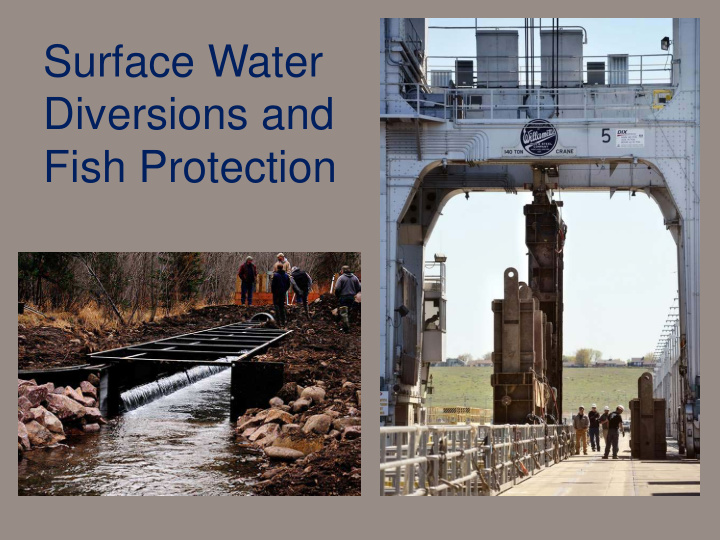



Surface Water Diversions and Fish Protection
The Need Taking Water Out of Its Natural Location
The Impact
Annika W. Walters, Damon M. Holzer, James R. Faulkner, Charles D. Warren, Patrick D. Murphy & Michelle M. McClure (2012 ): Quantifying Cumulative Entrainment Effects for Chinook Salmon in a Heavily Irrigated Watershed , Transactions of the American Fisheries Society, 141:5, 1180-1190 The cumulative effect of water diversion on smolt out-migration was substantial, the installation of fish screens would reduce entrainment by 50- 90%.
The History 1946 - WDFW began providing Endangered Species Act screening services
The Challenge
Screening Solutions • Biological Basic for Design Criteria – Swimming abilities – Size • NMFS keeper of the criteria and generally states follow • Physical Barriers are the standard over behavioral devices (lights, sound, electrical fields)
Screen Material Welded Screen (wedge wire) Profile Bar Screen
Screen Type In or On Channel Downstream Control No Bypass Off Channel Upstream Control
Diversion Type Off Channel Screen
Diversion Type On Channel
Screen Types • Off Channel – Rotating Drum (conventional style) – Horizontal Fixed Plate – Eicher Screen (inclined inside pipe screen) • On Channel – End-Of-Pipe Screens (cone, cylinder, etc..) – Tee-screen (fixed or rotating) – Floating Surface Collectors • Both (theoretically) – Fixed Vertical and Non-Vertical Plate – Vertical or Horizontal Traveling – belt and panel – Coanda (weir screen)
Rotary Drums
Rotary Drums • Susceptible to direct hits from large debris • Seals require much maintenance. • Susceptible to abrasions • Passing debris downstream may require debris screens if using sprinklers or hydro turbines • Requires careful attention to water depth – 65% to 85% submergence – May require checkboards downstream
Horizontal / Farmers Screen
Horizontal Plate Screen • More headloss than other screen, requires higher gradient system (~2% stream slope min) • Requires more bypass flow • Large civil footprint • Works well for: – High sediment systems – High organic debris systems – Remote sites with no power available
Vertical Traveling Screens
Vertical Traveling Screens PROS CONS • Can be installed on • Mechanically channel complex • Compact civil works • Seals can be a problem • Jet sprays provide additional cleaning. • Sediment can wear down belting • Possible to add trash conveyor behind • In some cases, screen to keep stretching has been debris out of canal an issue.
End of Pipe • Passive or Active • Often Wedge Wire • Air burst, bushed, back spray
End of Pipe – Cylinder
End of Pipe - Cones
End of Pipe - Advantages • Good option for deep intakes • Air burst cleaning system can be made to be effective • Some have effective brush cleaners • Some off-the-shelf models with water backwash systems meet NMFS criteria for active screens. • Some can be easily removed for off-season
End of Pipe - Disadvantages • Out of sight, out of mind (difficult maintenance) • Need current to transport debris from screen site. • Air burst systems on large installations don’t always clean entire screen - especially the bottom. • Long, stringy vegetation is a problem on small pump screens. • Requires sufficient depth to meet clearance criteria – ½ Screen diameter all around screen – Therefore min water depth must be 2x screen diameter
Vertical Panel
Cleaning Systems
Vertical Fixed Plate Screens • Mechanically simple and easy to seal • Can be installed on channel • Large bypass flows required if installed in canal • Brush arms can be damaged by large debris • Sediment accumulation can cause brush problems • Very tall screens can have difficulty holding brush tight to screen • Brush cleaners can be mechanically complex
Other Screens • Coanda Screen – Barrier – Not NMFS approved • Eicher Screen
Diversion Design Screen and Intakes work Together
Intake Design • Materials can vary – place or precast concrete, metal, wooden. • Bedload sediment transport can often be mitigated by intake design – Orientation to stream – What is the morphology of the stream
Intake Design • Entrance hydraulics • Headloss • Water Surface profile especially for gravity systems behind a headgate
Design Considerations - Trashracks • Trashracks have to be cleaned too! – Sweeping flow • In some cases, on channel T-screens or Cone screens should be equipped with trash racks deflectors.
Design Considerations - Sediment • Bedload vs suspended • Sediment sinks
Entrance Conditions and Screen Orientation • Avoid Turbulence and hotspots • On Channel Screens – Deflectors – Screen orientation to flow
Design Considerations - Bypass • If off stream screen is used, a formal bypass is required. • Balance of preventing backwater and not injuring fish
Design Considerations - Flooding
Maintenance • Will it last? – Is screen shielded from debris? – Is sediment management accounted for? – Is there a maintenance plan in place for the system? • Who is responsible for maintenance?
Summary • Often complex projects with multiple stakeholders with conflicting interests – Fish Passage and protection – Operations – Cost • There are very effective solutions • Can be a catalyst for more installation of more efficient infrastructure • Consider long term maintenance • Use your experience as a guide
Questions Shane Sheldon shane@vientoeng.com
From Screens to Irrigation Modernization • Allowed District to pipe and pressurize 11 kilometers of open canal • Allowed installation of 1 Megawatt of hydropower capacity • Allowed individual users to install center pivots and micros • District diverts 40% less water to irrigate the same number of acres • Removed 147 pumps from their system
Modern Irrigation • Farmers ID, OR • Constructed 2003 • 80 CFS maximum • 1 of 7 screens • 4.8 Megawatts of hydropower production • $550,000 USD
Screen Project Benefits • Saves $90,000 USD per year in operational costs • Increased hydro production by 23% • Facilitated piping and pressurization of 64 kilometers of open ditches • Allowed removal of over 1,400 pumps • Facilitated on farm improvements
Recommend
More recommend